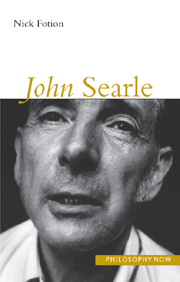12 - Truth, representation and epistemology
from Part III - Philosophy of society and other matters
Summary
Truth and facts
In one sense, this chapter signals the end of the discussion of Searle's theory of social reality. Up to now, Searle's attention has been mainly on ontological issues. What is social reality? How does it differ from non-social reality? He is also concerned with the related question: How does social reality work? The answer to these questions goes like this. Social reality emerges from nonsocial reality and Intentionality. Humans create institutional facts from brute facts. For many institutional facts we need brute facts in the form of physical markers such as paper or pieces of metal to help create money. We also need we-intentions to get the job done. Whatever else is needed, it is clear that social reality emerges from simpler forms of reality in such a way that there is no sharp separation between the materials used to create social reality and that reality itself. For Searle there is one reality; not two, three or more.
But as presented so far, the discussion of social reality has not said much about how we represent that reality. That is, little has been said about how it is we talk about it; and how it is that we know that when we speak about social reality we speak truly of it. So now Searle turns to these topics to complete his picture of that reality. However, in another sense, this chapter turns to new subjects having more to do with philosophy of language, and even more to do with theory of knowledge, than anything else.
- Type
- Chapter
- Information
- John Searle , pp. 231 - 240Publisher: Acumen PublishingPrint publication year: 2000



